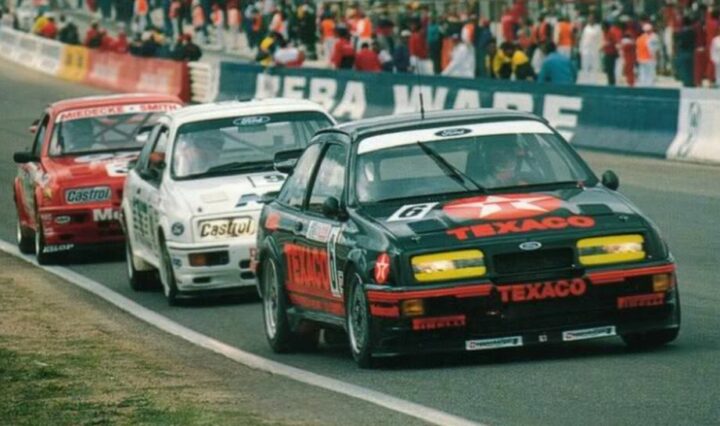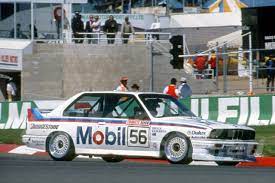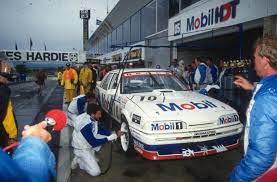by Brian Goulding
When Channel 7 began covering the Armstrong 500 at Mount Panorama, Bathurst, in 1963 I was 12. Sixty years ago, the Armstrong 500 was a 500-mile race for almost standard showroom touring cars. The previous three annual 500s took place at the fast Phillip Island circuit in Victoria, but the circuit surface was left in an irreparable condition after the 1962 event and the race needed a new home. The Australian Racing Drivers Club (ARDC) successfully convinced Armstrong to move to Bathurst, to start a tradition that lasted until 1998.

Like millions of Australians, we watched the race on TV every Sunday of the October long weekend. Fast forward to 1977 and I took the opportunity to call in at Mount Panorama on a trip to the Orange kart track. Like today’s first timers I was taken aback by the narrowness of the track, the steepness of the climb to the top of the mountain, the drop off over Skyline and the length of Conrod Straight – no chicane in those days.
By 1987 I was working for Caltex when they decided to get involved in Group A touring car racing with Colin Bond and the Alfa Romeo 75 Turbo. The marketing manager asked me to write a short history of the Bathurst 500/1000 as part of our handout for the Caltex dealers on their way to Bathurst. The editor of The Caltex Star, the in-house Caltex magazine, also asked me to interview Colin Bond after the race and write an article.
Group A regulations for touring cars were introduced in Britain and Europe in 1982. After Group A class was tried at the 1984 James Hardie 1000, Group A regs were used for all CAMS touring car races in Australia from January 1985. The 1987 1000 was to be a round of the first World Touring Car Championship and, to match the prestige of the event, the ARDC and Bathurst City Council had made several costly improvements to the circuit. The most noticeable were the new two storey pit building, the track deviation/chicane at the second hump on Conrod Straight and kilometres of new concrete trackside barriers. The $4m cost of the new pit complex was paid by the ARDC while the Bathurst City Council covered the cost of the new chicane by selling the naming rights. It was to be known as Caltex Chase.
The initial entry caused a lot of aggro from some regular local competitors who found themselves either not accepted or placed on a reserve list. Competitors doing the whole championship were asked to register at a cost of $US60,000 per car, so it was only fair that these cars received automatic entry to all rounds.
The driver line up was arguably the best ever. It was a case of the best touring car drivers in Australia taking on the best works touring car drivers from around the world.

The dramas started in practice and qualifying. The legality of the Eggenberger Texaco Ford Sierras was challenged by several local teams. Drivers who failed to get down to a time equal to 110percent of the average of the three fastest qualifiers in their class faced exclusion by the stewards. Eight cars failed to make the cut. The two Shell Team Ford Sierras were disqualified from the Top Ten Shootout due to illegal fuel – embarrassing.
Nine different manufacturers were represented on the starting grid. In the star-studded field, Ford Sierra RS500s were driven by Klaus Ludwig, Klaus Niedzwiedz, Steve Soper, Pierre Dieudonne, Andy Rouse, Thierry Tassin, Allan Moffat, Dick Johnson, Greg Hansford, Neville Crichton, Charlie O’Brien, Andrew Miedecke, Don Smith, John Giddings and Bruce Stewart.

Little 2.3 litre BMW M3s were the main opposition for the powerful 2-litre turbo Sierras. The M3s had a great driver line up too including Johnny Cecotto, Gianfranco Brancatelli, Jim Richards, Tony Longhurst, Roberto Ravaglia, Emmanuelle Pirro, Winni Vogt, Altfrid Heger, Olivier Grouillard, Gary Brabham, Juan Manuel Fangio (the third), Roland Ratzemberger, Markus Oestreich, Robbie Francevic, Ludvig Finnauer, Annette Meeuvissen and Mercedes Stermitz. The last two drivers were fully supported female works BMW drivers who made a useful team together. They were going well until unfortunately Stermitz crashed the car in practice.
Other potential winners were Allan Grice and Win Percy (Commodore), Larry Perkins and Denny Hulme (Holden Commodore), George Fury and Terry Shiel (Nissan Skyline) plus Glenn Seton and John Bowe (Skyline).
To our younger readers this list of drivers is merely a string of unusual sounding names, but to older enthusiasts and to students of the sport this was a quality entry with vast touring car experience. The scene was set.
Klaus Niedwiedz made an appalling start from pole position and lost about 15 places between the start and Hell Corner. Rouse led from Miedecke and Grice while Ostriech and Vogt elected to start from pit lane. At the Cutting on lap two the Crichton Sierra tried to dive under the Perkins Commodore and they touched. Both cars spun into the concrete wall and were out of the race. Dick Johnson quickly joined his team mate on lap three with a broken diff. Niedzwiedz was storming through the field in the Texaco Sierra and was up to fifth by lap six. Soper and Miedecke were battling for the lead and drawing away from Rouse in the Moffat Sierra. Around lap nine the Caltex Alfa 75 stopped on the circuit with a battery problem. The morale in the Caltex hospitality marquee took a nosedive. Bond got the car back to the pit garage, but he had lost a couple of laps and Lucio Cesario took over driving duties. On lap 31 Rouse went straight on at Hell Corner with a broken transmission.
Also on lap 31 Brock pitted the Commodore in a scheduled stop for tyres, fuel and driver change to Parsons. After three slow laps Parsons was back in with terminal engine problems leading to the retirement of 05 Mobil Commodore. Fortunately, Peter McLeod had double stinted in the 10 car. If John Crooke had taken over at the pitstop only Brock could have transferred to 10 as every car could only be driven by a maximum of three drivers. Because 10 had only been driven by McLeod both Brock and Parsons could transfer cars. Parsons’ faster pace (he was faster than Brock in car 10) would prove critical to the final result.
Just before midday, on its 34th lap, Cesario launched the Caltex Alfa 75 off the curb in the esses and went straight ahead on two wheels, cannoning into the concrete barrier and bouncing back onto the racing line. This brought out Mount Panorama’s first safety car. This little moment in history was made even more memorable when the Nissan Skyline safety car broke down.
The race was restarted with race control ordering green flags at every point…most drivers got the message. McLeod finally finished his double stint on lap 61 and Brock took over with the second Mobil Commodore in 10th place. At half distance the two Texaco Sierras led easily from Percy (Commodore), Brancatelli (BMW), Brock (Commodore), Stewart (Sierra), Fury (Skyline), Brabham (BMW), Seton (Skyline) and Longhurst (BMW).
About this time I introduced myself to Colin Bond. He had left the wreck of the Caltex Alfa 75 in the pit garage to mingle with the Caltex guests in the marquee at Caltex Chase. He was extremely calm and matter of fact when describing the Cesario crash but his infectious laugh, for which he was famous, was notably absent. “Looks like we will have to get a Sierra for next year” he said. He did and with Caltex-backing scored third in the Australian Touring Car Championship and third in the Bathurst 1000.
On lap 95 Dieudonne gave up the lead to pit and put Soper back in the car. This left Percy to lead in the Bob Jane T-Marts Commodore, but before he could complete one lap in the lead he was coasting in with differential and brake problems. The first rain shower hit the circuit on about lap 108 and lasted 13 minutes. During this time Channel 7 viewers were treated to fabulous Racecam footage from just behind the left shoulder of Glenn Seton as he wrestled the Nissan Skyline across the top of the mountain and down Conrod on slippery slicks in pouring rain. Even today, decades later, those who saw it still say it was the best Racecam footage ever.
At 130 laps for the leader Soper led Ludwig by 90 seconds in a Texaco Sierra 1-2 with Cecotto (BMW) two laps back and 50 seconds ahead of Parsons in the Brock Commodore. Within two laps a mini typhoon hit the circuit. Commentator Neil Crompton’s pit lane report described the wind as gale force, the temperature as freezing and the rain as horizontal. John Giddings put the second Oxo Sierra into the wall at the cutting bringing out the safety car again.
Meanwhile in the Caltex hospitality marquee at Caltex Chase pandemonium ensued as the mini typhoon hit the large circus tent. It was held up by three large poles but these wavered under the high winds and two of them collapsed. This left just the central pole in place to support the roof – no aluminium framework in those days. It was a case of many of the guests (and me) rushing to support all three poles until temporary repairs could be made by the hire company workers.
While the safety car was out two Corollas slid into the wall at McPhillamy Park and Graeme Bowkett had a long slow spin at the same spot. Fangio was next on the scene, and he had a slow motion slide into one of the crippled Corollas. Johnny Cecotto wacked the wall at Ried Park, pushing the left front wheel half a metre back into the bodywork. He managed to keep going, eventually finishing third in class B. There was more controversy at the restart. As a signal to the field and the marshals that the race would restart next time past the control line, the safety car turned off its lights as it exited turn one. However, when the safety car lights went out the number 43 BMW and number six Sierra pulled to the left and passed the safety car. The rest of the field followed suit.
Were they signalled to pass?
Because this was the first race meeting in Australia to use a safety car, mistakes could have been made. Whatever transpired no penalties were issued.
From pit lane Neil Crompton reported the Texaco Sierras may have been using illegal fuel. The Texaco cars had chosen not to use the control fuel supplied by the ARDC and when the CAMS scrutineers took samples from their Texaco drums and their overhead refuelling tanks one of them blew the test apart. Because the story had gone out over the TV coverage a crowd gathered behind the Eggenberger garage catcalling and jeering about the legality of the Sierras. As it turned out the legality of the fuel formed part of the official protest against the Texaco cars, but they were found innocent on this point.
On lap 153 of 161 Brock dived into pit lane to have intermediate tyres fitted. He lost about 35 seconds. He had a reputation for disliking racing on wets. He was always the last driver to change to wets and the first to change to slicks. The commentators embraced the prospect of the local hero gambling on the track drying quickly to suit his intermediate tyres. Unfortunately for Brock (and the commentators) when he resumed in third place, he found the tyres did not give him any more speed and he was still sliding all over the place. At one stage Brabham in the BMW passed Brock out of turn one as they both caught a back marker. As Brabham went by, Brock jumped to the left to pick up a tow but unfortunately, he moved directly in front of the fast approaching Soper Sierra. When he blocked Soper as they went up Mountain Straight Soper flicked on high beam lighting up the rear of the Mobil Commodore to highlight the speed differential. Very embarrassing as it reinforced the total dominance the Texaco Sierras enjoyed.

Soper and Dieudonne finished on 161 laps, teammates Ludvig and Niedzwiedz on 159 and Brock, Parsons and McLeod on 158. After the race the Eggenberger Sierras were the object of multiple protests by multiple Australian teams. The two main objections seemed to be the width of the front track achieved by using extra wide wheel arch extensions and use of illegal fuel. On November 13, 1987, the race stewards declared the two Texaco Ford Sierras to be illegal. Rudi Eggenberger instantly appealed to AMSAC, the Australian Motor Sport Appeals Court. On December 9, 1987 AMSAC rejected the appeal. Eggenberger appealed to FISA in France but on March 14, 1988, nine months after the race, Brock, Parsons and McLeod were declared winners of the 1987 James Hardie 1000.
It was not until 2005 that another attempt was made to run a World Touring Car Championship.

